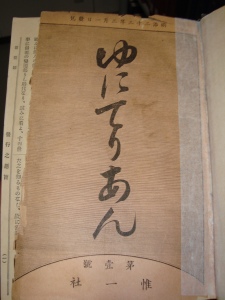Today at the Pullman Memorial Universalist Church’s blog, David Markham asserted that Jesus would probably have made a great Unitarian-Universalist. It’s hard to know–after all, virtually every Christian (and some non-Christian) group has made the same claim, telling us more about the seemingly endless ways to imagine Jesus than about what he was really like (if that’s even possible to accurately speculate about, at this point). Nevertheless, his vision of a UU-friendly Jesus is certainly appealing, and accords with particular readings of Jesus.
He then goes on to make the intriguing claim that Buddha too would make a good Unitarian-Universalist. If anything, this could be even more interesting, since the Buddha came from an even more different religious culture from our own than Jesus did. As with Jesus, it is extremely difficult to know who the historical Buddha truly was and what he taught and did not teach. Every single textual source we have the Buddha is a sectarian one committed to the form we currently have it hundreds of years after his death. In other words: there is no truly retreivable “historical Buddha,” only a variety of competing sectarian ones and speculatively “reconstructed” ones based on sectarian documents.
With that said, there is some broad agreement about the personality and some of the teachings of the Buddha. And, oddly enough, there does seem to be some alignment with UU principles. If we take the easy way out and reference the principles of the UUA (so much less than a creed, yet so tantalizingly convenient), the overlap is nothing short of remarkable:
- The inherent worth and dignity of every person;
- Justice, equity and compassion in human relations;
- Acceptance of one another and encouragement to spiritual growth in our congregations;
- A free and responsible search for truth and meaning;
- The right of conscience and the use of the democratic process within our congregations and in society at large;
- The goal of world community with peace, liberty, and justice for all;
- Respect for the interdependent web of all existence of which we are a part.
These are indeed ideas that match up very well with the best guess of the flavor of the Buddha’s original teachings. They aren’t perfect (the Sangha used democratic methods for some decision-making but was fundamentally based on a seniority system, for instance), but there’s a lot more in common than not. This is one reason that Buddhism has been a rapidly growing phenomenon within UUism: many UUs are impressed by how well their core principles align with Buddhism, allowing them to move into Buddhist practice with relative comfort.
But we should not stop the conversation here. The truth is that, while the principles listed above are one’s we can well imagine the Buddha broadly approving of, the Buddha himself would not have been a Unitarian-Universalist. At its heart, UUism is about a free, personal exploration of spirituality, without being told precisely what your goal should be or what path it should take. This was not the way of the historical Buddha, if our records are to be believed.
The Buddha taught specific dogmas that he held to be absolutely accurate descriptions of how things really are. He seems to have believed that he alone in the entire world had discovered true religion, and his followers agreed: that’s what “Buddha” means. A Buddha in the early tradition is the one person in a benighted world who has discovered the truth and teaches it to others; all other religious paths are inferior by definition. And the truths that make someone a Buddha are about karma, rebirth, dependent co-origination, non-self, suffering, detachment, impermanence, and nirvana. People who do not teach these dogmas are not in accord with actual reality, by the original (and still virtually all current) Buddhist understanding. The Buddha seems to have believed that people must be free to draw their own conclusions, but this did not prevent him from very, very clearly teaching that conclusions other than his own were incorrect, a fact that is often glossed over in the rush to make the Buddha into a comfortably modern ecumenical figure.
In other words, while the Buddha could accept the principles of UUism, he would not have been a UU because his religion contained so much more doctrinal content and practical method than does UUism, including additional principles that conflict with UUism in practice. And for that matter, there is more to UUism too than the UUA principles, including aspects of UUism that would not have appealed to the Buddha, such as the current UU fetishism of covenants and congregational polity, or common practices such as hymn-singing and joys and concerns (he totally would’ve been down with story for all ages, however).
This does not invalidate the growth of UU Buddhism, of course. Buddhists have continually reimagined Buddhism, often through contact with other cultures and religious paths that bring new perspectives and concerns to the pursuit of Dharma. If UUs imagine a Buddhism that is compatible with their religion, they are doing nothing different from (nor doing more violence to the tradition than) earlier Hindus, Confucianists, Shintoists, and others who likewise reimagined Buddha and Buddhism.

